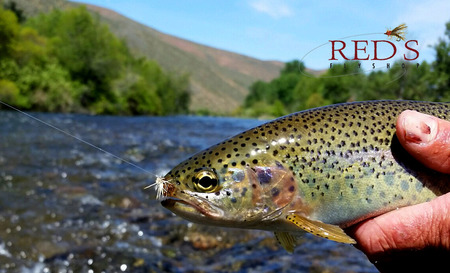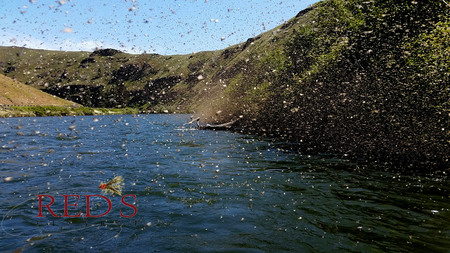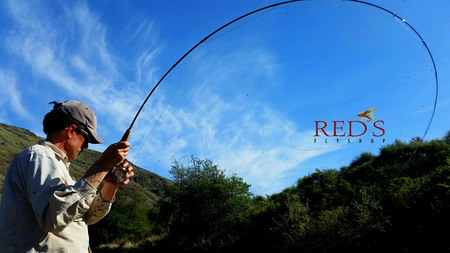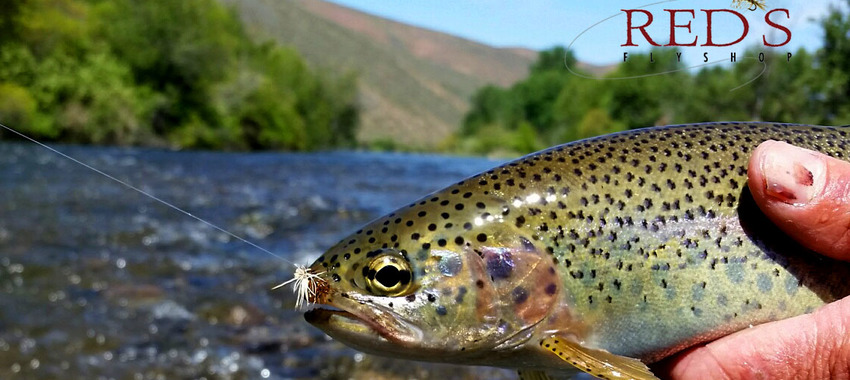Caddis Mania
May 11, 2015
Aside from a bump in flows that threw a temporary knuckle ball at us last week, and brushed us off the plate, the fishing has been outstanding. It appears that it will be above average to great throughout the upcoming week. That spike actually wasn't as bad as it looked, I personally hit the panic button for about 12 hours and realized that I underestimated the hatch and the trout's desire to fatten up. The fishing remained VERY good all the way through the peak. You never know. Try to wet a line this week if at all possible.
About the only thing that could pry me away from this hatch right now is to go someplace with shots at 8-10 pound Bonefish and Giant Trevally that may tip the scales at 60-100 pounds...have you heard of Christmas Island?! Not to rub it in, but I'm at a hotel in Honolulu right now ready to make the short flight to Christmas Island in the morning. I can't wait to step into that 75 degree water and spot that first fish. I will miss this Caddis hatch though. It has been quite good!
Suggested Dry Flies:
Blooms Parachute Caddis (floats great, easy to see, great for searching and general prospecting)
CDC Bloom's Caddis Emerger (harder to see, but "gets 'em!" Use this in situations where the fish is being picky but continues to rise)
Corn Fed Caddis (this is a good one to have, it is CDC but has a parachute post making it fairly easy to see, this is a good fly to search with in direct sunlight).
Better Foam Caddis (this is a total adult, don't bother using it early in the hatch but reserve it for fish along the bank or eating Caddis as they are crawling off the sticks)
X-Caddis (the BEST all around bug to have). It is an emerger that you can see. Get a pile of these trust me please. You will need to have a strong false cast to keep it floating but it catches fish!
A Few Nymphs... Use these in the morning/mid day
Lightning Bugs #14 - #18 (emphasis on Pearl and Silver) If you had to choose ONE nymph this would be it. Don't underestimate this fly.
Umpqua's Tungsten Beadhead Caddis Puape

CLASSIC!!! Here is a spunky Rainbow that we spotted feeding near some sticks and the angler after watching it rise a few times made a good plan and a good cast! He caught it on a classic Elk Hair Caddis.
The fish continued to feed heavy all way through this spike!

The biggest piece of advice I can give you is that if you want to catch fish on dry flies... fish dry flies and stick with it. On Saturday we wound up having a great day of dry fly fishing it would have been very easy to give up on it and "go down deep" nymph fishing. It would have been an "average" day on the river and certainly we would have landed some nice fish. Our goal though was to put about 10 nice fish in the net on dry flies. We employed a strategy called "headhunting" which means we pretty much floated down river scouting for a particular fish, and then assaulting the suspect with a well placed first cast. The routine is to find the fish, watch it feed a few times, throw a few drifts just short of the feeding lane to figure out what the fly is going to, and then taking the "shot". We caught some spectacular trout on the first pass over the fish.
I have said this MANY times, I have absolutely nothing against fishing indicators of any type in fact I do ton of it and am pretty good at it. However, you have to stick with dries and take your lashings in order to get better at fishing small dry flies. There is so much finesse, touch, and skill associated with placing a #16 emerger pattern in the exact lane of fish that it is without comparison the hardest skill fly fishing has to offer. Until we get down in the #18, 20, and 22 size range! It combines precise casting accuracy along with many other challenges.
Check out this hatch!

What is the Most Underrated Skill of the Guided Guest?
One of the most un appreciated skill sets that a guided guest brings to the drift boat is their ability to read water. I'm not talking about seeing an obvious hole here, or a ledge there either. I am talking about being able to take a mental snap shot of a few complex seamlies and decide exactly which seam will produce in a matter of seconds. Here are a few tips. I watch anglers fish side by side all the time and the guests that can combine casting accuracy with their ability to read the water produce the most hookups. The guide can only blabber so much without confusing the caster. At a certain point the anger needs to work the fly and make the small yet critical decisions for themselves.
- Look for overlooked seamlines. The easy ones have already been flogged.
- Try to identify seams that will harbor a natural float. Some seams have lots of fish, but are tough to get a good float. Look for a spot that will promote a good drift but is still likely to have a trout or two.
- Cast downstream if you are in a boat, cast upstream if you are on the bank
- Fish the near side of major boulders first.
- Fish downstream of dead sticks late in the day when Caddis are laying eggs (bouncing up and down on the surface).
- Fish the open water seamlines during the active hatch
- Watch the fish feed few times before making you cast, look for random and rouge boils or anything that will destroy a near perfect float.
Have a Hatch Rod Ready!

Here is a shot of an angler that borrowed by 7'6" Redington Classic Trout 2 weight equipped with a Redington Drift Reel. This rod was perfect for making some tight shots with little flies under the sticks. I believe javing a dedicated dry fly rod like this is crucial to maximizing your success. Especially when shots at feeding fish are at a premium.
![Reds Fly Shop [logo]](/img/reds-fly-shop/logo.png)
